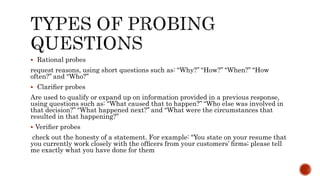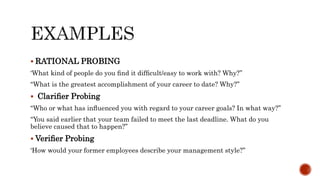Types of questions for interview
- 2. ? Open-ended questions ? Hypothetical questions ? Probing questions ? Close-ended questions ? How to relate the questioning techniques to interview stages ? Questioning techniques to avoid
- 3. ? open-ended questions require full, multiple-word responses. The answers generally lend themselves to discussion and result in information upon which the interviewer can build additional questions ? Open-ended questions encourage applicants to talk, thereby allowing the interviewer an opportunity to actively listen to responses, assess verbal communication skills, and observe the applicant¡¯s pattern of nonverbal communication
- 5. ? Hypothetical questions are based on anticipated or known job-related tasks for the available opening. The questions are phrased in the form of problems and presented to the applicant for solutions. The questions are generally introduced with words and phrases such as: ? ¡®¡®What would you do if . . .?¡¯¡¯ ¡® ? ¡®How would you handle . . .?¡¯¡¯ ¡®¡® ? How would you solve . . .?¡¯¡¯ ¡® ? ¡®In the event that . . .¡¯¡¯
- 6. ? Hypothetical questions allow for the evaluation of reasoning abilities, thought processes, values, attitudes, creativity, work style, and one¡¯s approach to different tasks ? applicants can offer responses based only on their previous experiences
- 7. ? These are questions that let interviewers delve more deeply for additional information they are usually short and simply worded
- 8. ? Rational probes request reasons, using short questions such as: ¡®¡®Why?¡¯¡¯ ¡®¡®How?¡¯¡¯ ¡®¡®When?¡¯¡¯ ¡®¡®How often?¡¯¡¯ and ¡®¡®Who?¡¯¡¯ ? Clari?er probes Are used to qualify or expand up on information provided in a previous response, using questions such as: ¡®¡®What caused that to happen?¡¯¡¯ ¡®¡®Who else was involved in that decision?¡¯¡¯ ¡®¡®What happened next?¡¯¡¯ and ¡®¡®What were the circumstances that resulted in that happening?¡¯¡¯ ? Veri?er probes check out the honesty of a statement. For example: ¡®¡®You state on your resume that you currently work closely with the of?cers from your customers¡¯ ?rms; please tell me exactly what you have done for them
- 9. ? RATIONAL PROBING ¡®What kind of people do you ?nd it dif?cult/easy to work with? Why?¡¯¡¯ ¡®¡®What is the greatest accomplishment of your career to date? Why?¡¯¡¯ ? Clari?er Probing ¡®¡®Who or what has in?uenced you with regard to your career goals? In what way?¡¯¡¯ ¡®¡®You said earlier that your team failed to meet the last deadline. What do you believe caused that to happen?¡¯¡¯ ? Veri?er Probing ¡®How would your former employees describe your management style?¡¯¡¯
- 10. ? These are questions that may be answered with a single word¡ªgenerally yes or no. Close-ended questions can be helpful in a number of ways: They give the interviewer greater control; put certain applicants at ease; are useful when seeking clari?cation; are helpful when you need to verify information; and usually result in concise responses
- 11. ? ¡®¡®How often do you travel in your current job? ? ¡®Are you aware that the starting salary for this job is $975 per week? ? Based on what you have told me so far, can I assume that you prefer working independently rather than as part of a team?
- 12. ? Rapport-Building Stage This stage, sets the tone for the rest of the meeting. The purpose is to put applicants at ease, thereby encouraging them to communicate openly and allowing you to determine job suitability. Close-ended questions that are casual in nature and focus on non-job-related topics will accomplish this goal. Did you have any trouble getting here? Were you able to ?nd parking nearby? How was the traf?c getting here?
- 13. ? THIS is intended to accomplish two key objectives: to help still-nervous applicants feel at ease and To allow the interviewer to start assessing their job suitability. These objective are best accomplished by posing two to three open-ended questions Introductory questions should be about topics familiar to the applicant so as not to create undue pressure ? ¡®Can you give me an overview of your past experiences with bene?ts administration? ? ¡®Why don¡¯t we begin with your current job. Would you describe your involvement in the day-to-day operation of your department
- 14. ? ,this is the most substantive segment of the interview. Here, the interviewer gathers all relevant information about the applicant based on the four categories of tangible skills, knowledge, behavior, and interpersonal skills, examining them in relation to the requirements and responsibilities of the job ? This stage represents 85 percent of the interview, with as much as 65 percent of it devoted to competency-based questions. That leaves about 20 percent of the time to be divided between four other types of questions: close-ended, open-ended, probing, and hypothetical.
- 15. ? This the ¡®¡®last chance¡¯¡¯ stage of the interview. At this point the interviewer needs to make sure she¡¯s covered all relevant competencies needed to make a screening or hiring decision, and the applicant has one last opportunity to sell himself. Closing represents 5 percent of the interview, and should be devoted to competency-based questions such as: ? ¡®What more can you tell me about your work with employee assistance programs to help me understand your experience in this are
- 16. ? ¡®¡®What is your greatest strength?¡¯¡¯ the applicant could reply, ¡®¡®I excel at problem solving.¡¯¡¯ Good question; good answer, right? Not really. What have your learned about the applicant? Absolutely nothing. If you want to know about a person¡¯s strengths ? try the two-pronged approach: Ask theopen-ended trait question ?rst:¡®¡®What isyour greateststrength?¡¯¡¯ Then follow up with the competency-based question: ¡®¡®Give me an example of how you¡¯ve used your greatest strength at your current job.¡¯¡¯
Editor's Notes
- #13: ¡®¡®Did you have any trouble getting here?¡¯¡¯ ¡®¡®Were you able to ?nd parking nearby?¡¯¡¯ ¡®¡®How was the traf?c getting here?¡¯¡¯
















